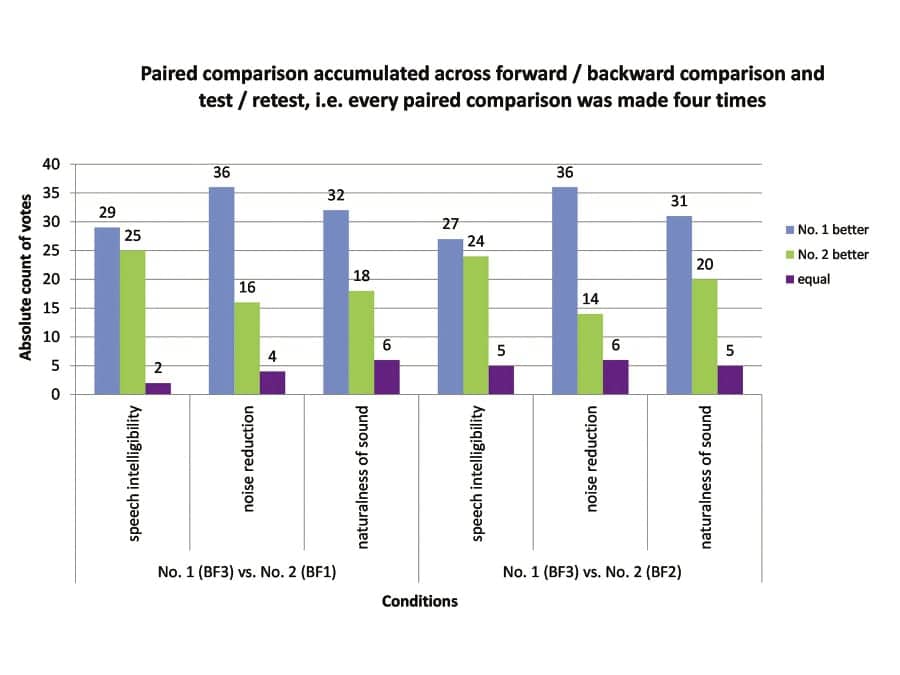Tech Topic | October 2013 Hearing Review
By Steffen Kreikemeier, PhD, Sabine Margolf-Hackl, juliane Raether, Dipl-Ing(Fh), Elmar Fichtl, PhD, and Jürgen Kiessling, PhD
In recent years, wireless technology has provided the opportunity to couple the right and left hearing aids, thereby improving the beamforming properties of the devices. This study looks at three directional responses in a challenging environment for people with moderate-to-severe loss. Beamforming responses were preferred over omnidirectional settings, and a binaural narrow beamforming response was preferred over the monaural static and adaptive beamforming response under the test conditions.
The primary task of hearing aids is the restoration of the ability to communicate. Speech understanding in quiet is not a big challenge for most hearing aid users with mild to moderate hearing loss. The biggest difficulties are reported in group conversations in noisy environments, when speech is masked by speech babble and/or music, the so-called cocktail party effect.1
To overcome this problem and improve the signal-to-noise ratio (SNR), the most straightforward approach is to attenuate the noise before it accesses the signal transmission chain. One of the most successful approaches is the use of directional microphones.2,3 Nevertheless, speech understanding in loud environments and/or large groups is still one of the most demanding tasks for hearing aid users.4
Today wireless solutions and complex directional microphone technologies are used. The utmost achievement in directional microphone technology is based on wireless communication between right and left hearing aids to exchange audio data received by the independent microphones of both left and right hearing aids. This can be used to achieve extremely narrow beamforming. Such narrow beamformers are intended to optimize the SNR in exceptionally difficult listening situations.
Methods
In a laboratory study carried out at the Department of Audiology of the University Hospital Gießen, three different directional microphone technologies and an omnidirectional system were compared and evaluated in complex sound setups.
In this study, 14 hearing aid users (9 female and 5 male) with symmetrical moderate-to-severe sensorineural hearing loss served as test persons. The mean age was 75 years (range: 50-84 years) and the hearing aid experience was 6.4 years on average. In two sessions, the pure-tone audiogram was measured for air and bone conduction (Figure 1).

|
| Figure 1. Mean air conduction hearing loss ± standard deviation. |
Hearing instruments (Naida S IX SP) were fitted using the manufacturer’s fitting rule (Adaptive Phonak Digital) followed by fine-tuning if needed. The hearing aids were coupled to the ear with the individual earmolds and ventings to achieve real-life conditions as much as possible. In the first session, four manual listening programs with different functionalities of the beamformer (BF) were created and programmed into the hearing aids (1 omnidirectional microphone setting and 3 different beamforming settings) for comparison:
• Omnidirectional microphone;
• Monaural static beamformer (BF1);
• Monaural adaptive beamformer (BF2);
• Binaural static beamformer (BF3).
Speech recognition thresholds (SRT for 50% correct) were measured using the Oldenburg Sentence Test5 for all test conditions. Accordingly, speech was presented from the front. The background noise was simulated by a diffuse speech-shaped cafeteria noise created by 7 uncorrelated noise sources at 45°, 90°, 135,° 180°, 225°, 270°, and 315°. The overall noise level was kept constant at 63.5 dB(A), chosen to serve as a compromise between an acceptable noise level and very loud situations in everyday life. The test person was placed in the center of a circle of loudspeakers (diameter 2 m).
In addition, the subjects were asked about their favorite directional microphone technology in single blind paired comparisons for sound samples at 0 dB SNR (speech under 0°) in terms of speech intelligibility, effectiveness of noise reduction, and naturalness of sound.
Results
As shown in Figure 2, on average, the speech recognition threshold (SRT) for the omnidirectional microphone setting was inferior compared to any of the beamformers. The SRT results for the beamformers with different directionalities and functionalities (static or adaptive) are very similar in the noise condition chosen for this experiment. Figure 2 also shows a fairly high test-retest reliability of the SRT data for all test conditions. Statistical analysis reveals that all beamformers provide highly significant (p = 0.01 better SRTs than the omnidirectional microphone; the results of the three beamforming algorithms do not differ significantly.

|
| Figure 2. Results of the Oldenburg Sentence Test in a diffuse cafeteria noise shown as boxplot (containing median, interquartile range, minima and maxima). Test (blue) and retest (green) SRTs for different microphone characteristics and beamformer functionalities. Omni: omnidirectional microphone characteristic; BF1: monaural static beamformer; BF2: monaural adaptive beamformer; BF3: binaural beamformer. |
Although the SRT data for the three different beamformers (see BF1-BF3 from Figure 2) turned out to be similar, in randomized single blinded paired comparisons, the binaural beamformer (BF3) was preferred over the monaural beamformers BF1 and BF2 in terms of speech intelligibility, effectiveness of noise reduction, and naturalness of sound (Figure 3). The adaptive BF2 was preferred over the static BF1.

|
| Figure 3. Subjective rating of the beamformers using single blinded paired comparison in terms of speech intelligibility, effectiveness of noise reduction, and naturalness of sound. BF1: monaural static beamformer; BF2: monaural adaptive beamformer; BF3: binaural beamformer. |
Conclusion
The results show that, in complex listening situations, narrow beamforming (binaural BF)—which has been achieved by wireless coupling of left and right hearing aids—is preferred over the two types of conventional monaural beamformers evaluated in this study. However, it should be pointed out that SRT outcomes did not show any significant differences in this test setup with speech from the front in a diffuse cafeteria noise, unlike the results reported by Stuermann6 and Nyffeler.7 While Nyffeler was using the same setup as used in the present study for a different group of subjects, Stuermann worked with a different setup with 5 loudspeakers (at 60°, 120°, 180°, 240°, and 300°) with a radius of 1.4 m.
Obviously, the binaural directional microphone solution providing an extremely narrow beam gives measurable relief in diffuse noise fields in terms of speech intelligibility, listening effort, and sound quality. SRT measurements that aim for 50% correct speech reception threshold seem to be dependent on the general noise configuration setup (eg, background level and room properties), but also reflect the variety of real-life listening situations.
References
1. Bronkhorst A. The cocktail party phenomenon: a review of research on speech intelligibility in multiple talker conditions. Acoustica. 2000;86:117-128.
2. Ricketts T, Mueller G. Making sense of directional microphone hearing aids. Am J Audiol. 1999;8:117-127.
3. Chung K. Challenges and recent developments in hearing aids. Part I. Speech understanding in noise, microphone technologies and noise reduction algorithms. Trends Amplif. 2004;8(3):83-124.
4. Kochkin S. MarkeTrak VIII: Customer satisfaction with hearing aids is slowly increasing. Hear Jour. 2010;63(1):11-19.
5. Wagener K, Kühnel V, Kollmeier B. Entwicklung und Evaluation eines Satztests in deutscher Sprache I: Design des Oldenburger Satztests. Z Audiol. 1999;38(1):4-15.
6. Stuermann B. (2011). Naída S and ZoomTechnology—State of the art directionality for power users. Stafa, Switzerland: Phonak Field Study News. Available at: http://www.phonakpro.com/content/dam/phonak/gc_hq/b2b/en/elearning/publications/fsn/2011/FSN_Naida_S_Zoom_Technology_V1.00_07-2011.pdf
7. Nyffeler M. (2010). StereoZoom—Improvements with directional microphones. Stafa, Switzerland: Phonak Field Study News. Available at: https://www.phonakpro.com/content/dam/phonak/b2b/C_M_tools/Library/Field_Study_News/en/FSN_2010_September_GB_StereoZoom.pdf
About the Authors
Steffen Kreikemeier, PhD, Sabine Margolf-Hackl, and Jürgen Kiessling, PhD, are associated with the Department of Audiology at the University Hospital Giessen and Marburg GmbH in Giessen, Germany; Juliane Raether, DIPL-ING(FH), and Elmar Fichtl, PhD, are associated with Phonak AG in Stafa, Switzerland.
CORRESPONDENCE can be addressed to Steffen Kreikemeier at: [email protected]
Citation for this article: Kreikemeier S, Margolf-Hackl S, Raether J, Fichtl E, Kiessling J. Comparison of different directional microphone technologies for moderate-to-severe hearing loss. Hearing Review. 2013;20(11):44-45.
October 2013 Hearing Review





